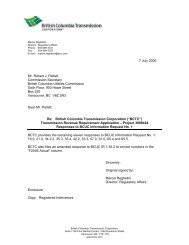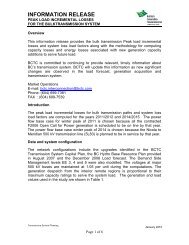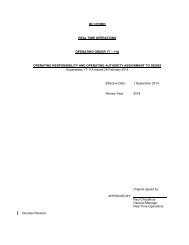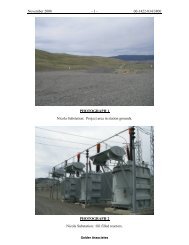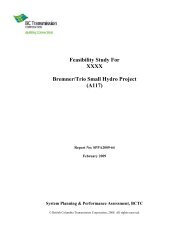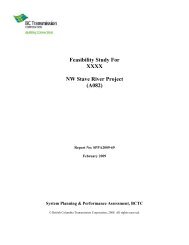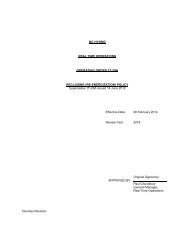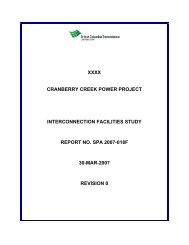Evidence on the Adequacy of First Nations Consultation - BC Hydro ...
Evidence on the Adequacy of First Nations Consultation - BC Hydro ...
Evidence on the Adequacy of First Nations Consultation - BC Hydro ...
You also want an ePaper? Increase the reach of your titles
YUMPU automatically turns print PDFs into web optimized ePapers that Google loves.
DRAFT REPORT: Rights and Title Interests in <strong>the</strong> Columbia Valley Transmissi<strong>on</strong> Project Area<br />
Lakes area, catching and drying salm<strong>on</strong>. 210 After this time, some <strong>of</strong> <strong>the</strong>m went across <strong>the</strong><br />
Rockies to <strong>the</strong> fall bis<strong>on</strong> hunt, and o<strong>the</strong>rs went down <strong>the</strong> Columbia to Golden, or even bey<strong>on</strong>d, to<br />
Yellowhead Pass, to hunt deer and elk. The “kátamukinik” were also known as “kulnaki” from<br />
<strong>the</strong>ir practice <strong>of</strong> pulling hide sleeves over <strong>the</strong> bows <strong>of</strong> <strong>the</strong>ir bark canoes as a protecti<strong>on</strong> in icefilled<br />
streams. Schaeffer pointed out that <strong>the</strong> “kátamukinik” sometimes moved up Sheep Creek<br />
and across Elk Pass to <strong>the</strong> headwaters <strong>of</strong> Elbow River. The “kátamukinik” people were almost<br />
entirely wiped out by <strong>the</strong> smallpox epidemic <strong>of</strong> 1781-1782, Schaeffer wrote, although <strong>the</strong>ir<br />
leader, a man named “Gray-Head” survived and eventually repopulated his group who <strong>the</strong>n<br />
became known as <strong>the</strong> “akískənəkinik”. 211<br />
Still under <strong>the</strong> leadership <strong>of</strong> “Gray-Head,” former leader <strong>of</strong> <strong>the</strong> “kátamukinik” people prior to<br />
<strong>the</strong>ir decimati<strong>on</strong> by smallpox, and followed by subsequent leaders, <strong>the</strong> “akískənəkinik” people<br />
c<strong>on</strong>tinued a similar annual round as that which had been followed by <strong>the</strong> “kátamukinik”. One<br />
excepti<strong>on</strong> was that <strong>the</strong> “akískənəkinik” tended to aband<strong>on</strong> <strong>the</strong> deer and elk hunting trips down <strong>the</strong><br />
Columbia and Canoe Rivers undertaken by <strong>the</strong>ir predecessors, in favour <strong>of</strong> bis<strong>on</strong> hunting<br />
excursi<strong>on</strong>s across <strong>the</strong> Rockies. 212<br />
Elsewhere Schaeffer stated that “akískənəkinik” is derived from <strong>the</strong> term “akískənik” meaning<br />
‘two lakes,’ referring to <strong>the</strong> main camp site—and <strong>on</strong>e <strong>of</strong> <strong>the</strong> wintering sites <strong>of</strong> <strong>the</strong>se people—<br />
located “near Fairm<strong>on</strong>t Springs between Columbia and Windermere Lakes.” 213 On ano<strong>the</strong>r<br />
occasi<strong>on</strong> in his fieldnotes Schaeffer wrote that <strong>the</strong> “akískənəkinik” people made use <strong>of</strong> <strong>the</strong> hot<br />
210 On ano<strong>the</strong>r occasi<strong>on</strong>, a different Aboriginal c<strong>on</strong>sultant interviewed by Schaeffer (1934-1969, Reel 2)<br />
stated that “kátamu” was “a regular place <strong>on</strong> Toby Creek, at Columbia Lakes, where <strong>the</strong>se people [<strong>the</strong><br />
“kátamukinik”] secured <strong>the</strong>ir sec<strong>on</strong>d batch <strong>of</strong> salm<strong>on</strong>” (as menti<strong>on</strong>ed below, <strong>the</strong>y obtained <strong>the</strong>ir first catch <strong>of</strong> salm<strong>on</strong><br />
in <strong>the</strong> vicinity <strong>of</strong> Brisco). To this Schaeffer added <strong>the</strong>y, “must have spend c<strong>on</strong>siderable time <strong>the</strong>re [at “kátamu”],<br />
since that name was given <strong>the</strong>m.” He also menti<strong>on</strong>ed two o<strong>the</strong>r c<strong>on</strong>sultants’ statements that <strong>the</strong> “kátamukinik” “lived<br />
more <strong>on</strong> fish than <strong>on</strong> game.” As well, Schaeffer noted <strong>the</strong>re was a camp site at “kátamu”.<br />
211 Schaeffer 1934-1969, Reels 1 and 2.<br />
212 Schaeffer 1934-1969, Reel 1.<br />
213 Schaeffer (1934-1969, Reel 2) identified three o<strong>the</strong>r wintering sites within this general area:<br />
“akinmiłukóuwat” meaning ‘bunch grass’, described as a post-horse site located “at mouth <strong>of</strong> small creek emptying<br />
in [into] Columbia Lake” and said to be a good place to winter horses as <strong>the</strong>re was lots <strong>of</strong> bunch grass here. No<br />
fur<strong>the</strong>r informati<strong>on</strong> was provided as to this site’s exact locati<strong>on</strong>; “ya’kuwʋłak” meaning ‘inlet’ and described as an<br />
“inlet <strong>on</strong> east side <strong>of</strong> Columbia, about 8 to 10 miles north <strong>of</strong> Canal Flats.” This descripti<strong>on</strong> fits <strong>the</strong> locati<strong>on</strong> <strong>of</strong> what<br />
appears to be a small inlet forming <strong>the</strong> nor<strong>the</strong>asternmost end <strong>of</strong> Columbia Lake, across from <strong>the</strong> outlet <strong>of</strong> Dutch<br />
Creek. O<strong>the</strong>r informati<strong>on</strong> provided by Schaeffer about this place includes <strong>the</strong> statement that <strong>the</strong>re are “rock paintings<br />
near here at inlet”; and, “yakinukuk” (?) meaning ‘rib <strong>of</strong> yawunik’, described as a “small prairie at mouth <strong>of</strong> Dutch<br />
Creek” which is located at <strong>the</strong> northwesternmost end <strong>of</strong> Columbia Lake. C<strong>on</strong>cerning this place, Schaeffer also<br />
noted: “Moss abundant here and roasted in spring—presumably this is a reference to “tree moss” [black tree lichen<br />
(Alectoria frem<strong>on</strong>tii)] which was ga<strong>the</strong>red and pit-cooked as food (see <strong>the</strong> “Ga<strong>the</strong>ring” secti<strong>on</strong> that follows).<br />
Bouchard & Kennedy Research C<strong>on</strong>sultants Page 50<br />
Page 53 <strong>of</strong> 200






